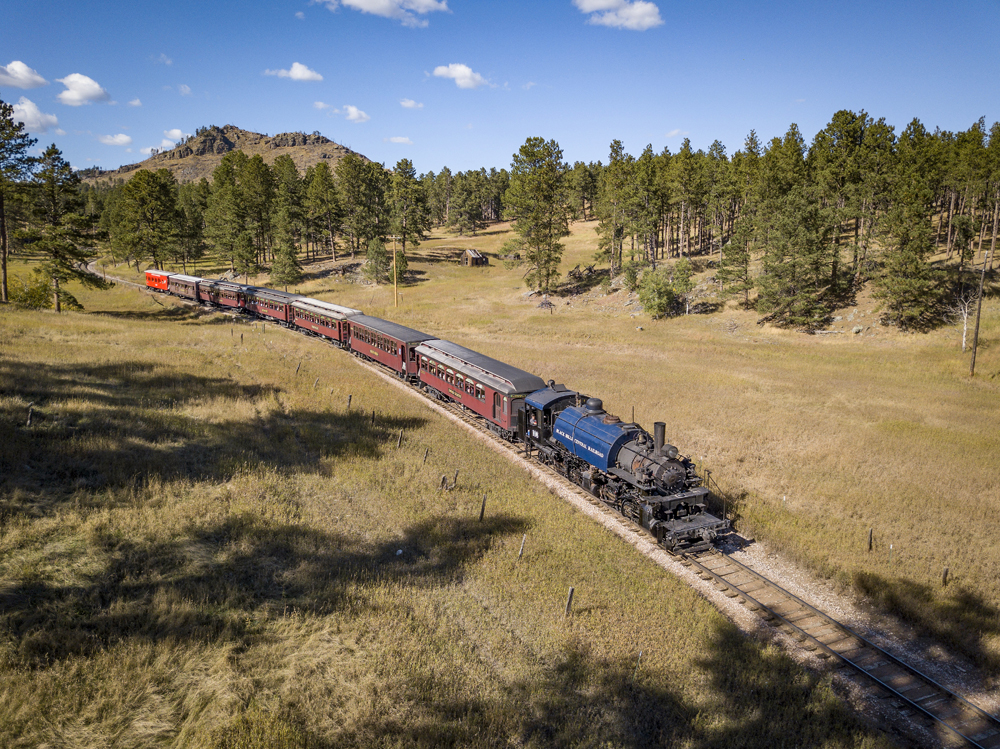Black Hills Central Railroad

This may surprise you, but the Black Hills Central is one of America’s oldest tourist railroads and today is among the most active steam railroads in the country. Best of all, it is one of the few places where you can see Mallet compound locomotives in action. From May through October, the railroad’s 1880 Train offers family-friendly scenic excursions on a 20-mile round trip between Hill City and Keystone, running several times daily.
The railroad prides itself in steam operations and boasts of its variable itineraries that give visitors a choice of departure and return trips from stations at Hill City and Keystone at opposite ends of the line. Business Operations Manager Nate Anderson explains that the schedule “allows for maximum flexibility, and many families use the railroad as a tourist shuttle between the two popular towns.” Hill City is the railroad’s base of operations and is home to its shop, yard, and the location of a large parking lot for visitors.
Founded in the mid-1950s by William Heckman, this tourist line began as a narrow-gauge train on Chicago, Burlington & Quincy’s Keystone Branch and gradually evolved into a standard-gauge steam operation. The line had primarily served as a branch off Burlington’s Edgemont to Deadwood route to serve the Black Hills mining industry around Keystone.
In its early days, Heckman arranged with the Burlington to lay a third rail on this lightly used line between Hill City and the midway point to Keystone called Oblivion, where he built a wye to turn steam engines. In the early years, excursions were largely hauled by former White Pass & Yukon 2-8-0 No. 69. Operations expanded after purchase of 2-6-2 No. 7, a standard-gauge engine originally built for the Prescott & Northwestern.
Anderson relates that standard-gauge operations began in 1962, and for a brief time the railroad operated both narrow- and standard-gauge excursions enabling passengers to change trains at Oblivion. While narrow-gauge excursions ended in 1964, a vestige of the wye reminds visitors of the railroad’s slim gauge days. Black Hills Central bought two additional locomotives in 1965: Nos. 103 and 104 are both former Peninsula Terminal 2-6-2Ts.
In 1990, after more than three decades, Black Hills Central was sold to the Warder family, whom have operated the railroad ever since. They injected life and energy into the railroad, investing
heavily in refurbishing equipment and tidying up the operation. The out of period bright colors that had adorned equipment during the 1970s and 1980s were replaced with more sedate traditional paint schemes. To grow the business, more powerful locomotives were purchased.
In 1999, the railroad bought 2-6-6-2T No. 110 from the Nevada State Railroad Museum and spent to two years restoring it to operation. When completed in 2001, it was the only operational example of a Mallet compound in North America. This large saddle-tank logging engine is well-suited to the steep grades in the Black Hills, that in some places exceed a 5% climb. Where No. 104, which had been the primary motive power for many years, could haul just four passenger cars up the grade east from Hill City, No. 110 could handle up to seven cars.
Success with this big engine led the railroad in 2015 to acquire a second Baldwin 2-6-6-2T Mallet, No. 108. Built by Baldwin in 1926 for the Potlatch Lumber Company and later labored for the Weyerhaeuser Company, this engine had been displayed at the Northwest Railway Museum in Snoqualmie, Washington. Black Hills restored it to operation in 2020.
Locomotive No. 104 is retained for standby service and may occasionally fill in during the shoulder seasons. Old No. 7 is now a static display piece, typically presented at the north end of the short surviving section of the Deadwood line at Hill City. The locomotive is remembered for its starring roles in the long-running television show Gun Smoke, and in movies Scandalous John (Disney, 1971), and Orphan Train (made for CBS television in 1979), and still retains its Hollywood-inspired diamond stack from the former film.
The Black Hills Central serves a popular tourist area and people come to visit the nearby Mount Rushmore National Park (just a few miles from Keystone station) and the Crazy Horse Memorial (12 miles southwest of Hill City). When you visit Hill City, stop into the South Dakota State Railroad Museum adjacent to the railroad station. This features an enormous model railroad and railroad artifacts.
For museum admission information, visit www.sdrm.shop.









